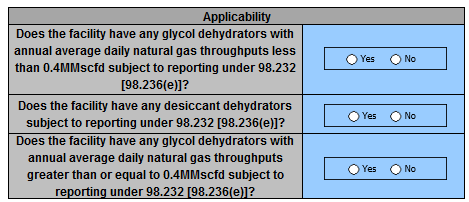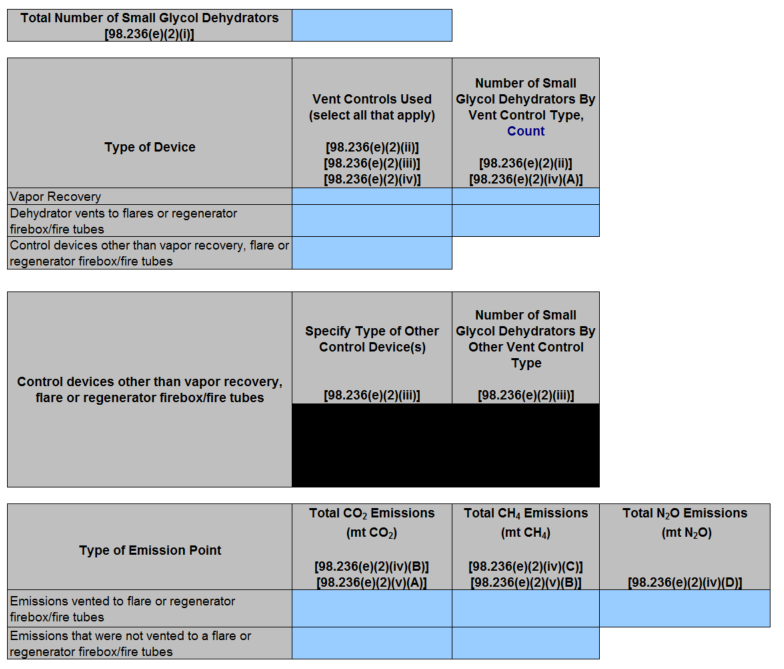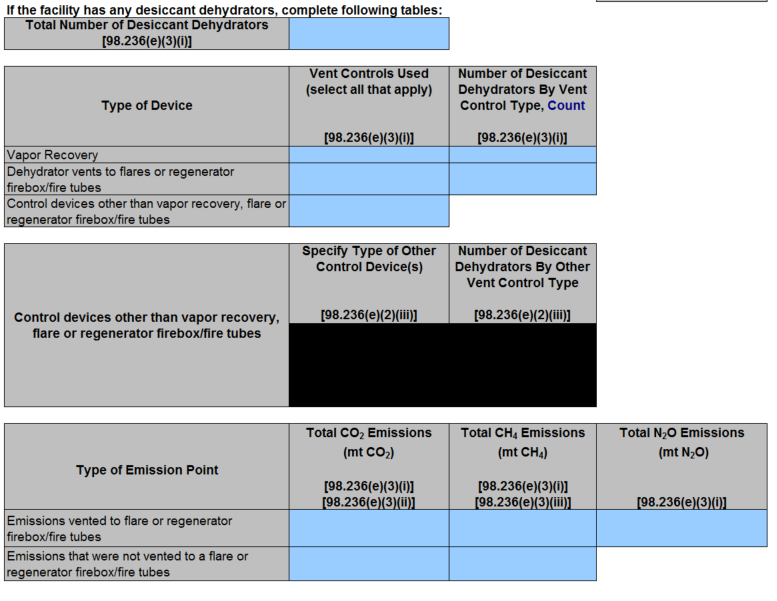This page provides an overview of the dehydrators source type reporting requirements for Subpart W.
Please see Reporting Form Instructions instructions on downloading the blank reporting form and uploading the completed reporting form.
You may also refer to Optional Calculation Spreadsheet Instructions to download the Subpart W calculation spreadsheet.This page provides an overview of the Subpart W dehydrators source category e-GGRT reporting requirements.
The dehydrators source category is applicable to Onshore Petroleum and Natural Gas Production and Onshore Natural Gas Processingtype is applicable to Onshore petroleum and natural gas production (98.236(a)(2)), Onshore natural gas processing (98.236(a)(3)), and Onshore petroleum and natural gas gathering and boosting (98.236(a)(9)) facilities.
Indicate if the facility has the source type via the radio buttons.
If the source type is present you must report required emissions.
If the facility has the source type,
...
- For further information, see Best Available Monitoring Methods and Missing Data Reporting.
Reporting Requirements
then indicate whether missing data procedures were used.
Reporting Requirements
Table E.1 Small Glycol Dehydrators must be completed if the facility has any with glycol For all glycol dehydrators with an annual average daily throughput less than 0.4 MMscfd, the facility is required to report:. Required data elements include:
Total number of small glycol dehydrators (98.236(e)(2)(i))
- What vent gas controls devices are used? ( (98.236(ce)(42)(ii-iv)(B))
- Vapor Recovery
- Dehydrator Vents to Flares
- Regenerator fire-box/fire-tubes
- No vent controls
- Other or Multiple Vent Gas controls. For this row also provide description in "Describe "Other" gas vent controls" column.
- Annual total CO2 emissions at the facility level that resulted from venting gas directly to the atmosphere combined for all glycol dehydrators for each vent control category with annual average daily throughput less than 0.4MMscfd (98.236(c)(4)(ii)(C)). Do not include those amounts which have been captured or recovered and are not vented to the atmosphere.
- Annual total CH4 emissions at the facility level that resulted from venting gas directly to the atmosphere combined for all glycol dehydrators for each vent control category with annual average daily throughput less than 0.4MMscfd (98.236(c)(4)(ii)(C)). Do not include those amounts which have been captured or recovered and are not vented to the atmosphere.
- Annual total CO2 emissions at the facility level that resulted from the flaring of process gas combined for all glycol dehydrators for each vent control category with annual average daily throughput less than 0.4MMscfd (98.236(c)(4)(ii)(D))
- Annual total CH4 emissions at the facility level that resulted from the flaring of process gas combined for all glycol dehydrators for each vent control category with annual average daily throughput less than 0.4MMscfd (98.236(c)(4)(ii)(D)) Annual total N2O emissions at the facility level that resulted from the flaring of process gas combined for all glycol dehydrators for each vent control category with
- )
Number of small glycol dehydrators by vent control type (98.236(e)(2)(ii), 98.236(e)(2)(iv)(A))
Specify the type of control devices other than vapor recovery, flare or regenerator firebox/fire tube, and specify the number of small glycol dehydrators that route emissions to each type of control device (98.236(e)(2)(iii))
- For dehydrators that route emissions to a flare or regenerator firebox/fire tubes, report total CO2, CH4 and N2O emissions from the flare or regenerator firebox/fire tubes (98.236(e)(2)(iv)(B-D))
- CO2 and CH4 emissions that were not routed to a flare or regenerator firebox/fire tubes (98.236(e)(2)(v)(A-B))
Table E.1 Small Glycol Dehydrators
Table E.2 Desiccant Dehydrators must be completed if the facility has any desiccant dehydrators with an annual average daily throughput less than 0.4 MMscfd. Required data elements include:
- Total count of desiccant dehydrators .4MMscfd (98.236(e)(c3)(4i))
- What vent gas controls devices are used? (98.236(e)(ii3)(Di))
For all absorbent desiccant dehydrators, the facility is required to report:
Number of desiccant dehydrators by vent control type (98.236(e)(3)(i))
- Total Count of Absorbent Desiccant Dehydrators
Specify the type of control devices other than vapor recovery, flare or regenerator firebox/fire tube, and specify the number of desiccant dehydrators that route emissions to each type of control device
(98.236(
ce)(
43)(
iii)(Ai))
Annual total CO2 emissions at the facility level for all absorbent desiccant dehydrators combined - For dehydrators that route emissions to a flare or regenerator firebox/fire tubes, report total CO2, CH4 and N2O emissions from the flare or regenerator firebox/fire tubes (98.236(ce)(43)(iiii)(B))Annual total CH4 emissions at the facility level for all absorbent desiccant dehydrators combined )
- CO2 and CH4 emissions that were not routed to a flare or regenerator firebox/fire tubes (98.236(ce)(43)(ii-iii)(B))
For each glycol dehydrator with a throughput greater than or equal to 0.4 MMscfd, the facility is required to report:
- Unit ID or Name, this is only required if the facility is reporting under the Onshore Natural Gas Processing industry segment
- What vent gas controls are used? (98.236(c)(4)(i)(I))
- Vapor Recovery
- Dehydrator Vents to Flares
- Regenerator fire-box/fire-tubes
- Other - Report other if control type is not listed or multiple control types are used. Provide description in "Describe "Other" gas vent controls" column.
- No vent controls
- Annual CO2 emissions that resulted from venting gas directly to the atmosphere (98.236(c)(4)(i)(J)). Do not include those amounts which have been captured or recovered and are not vented to the atmosphere.
- Annual CH4 emissions that resulted from venting gas directly to the atmosphere (98.236(c)(4)(i)(J)). Do not include those amounts which have been captured or recovered and are not vented to the atmosphere.
- Annual CO2 emissions that resulted from flaring process gas from the dehydrator (98.236(c)(4)(i)(K))
- Annual CH4 emissions that resulted from flaring process gas from the dehydrator (98.236(c)(4)(i)(K))
- Annual N2O emissions that resulted from flaring process gas from the dehydrator (98.236(c)(4)(i)(K))
Table E.2 Desiccant Dehydrators
Table E.3 Large Glycol Dehydrators must be completed if the facility has any glycol dehydrators with a throughput >0.4 MMscfd. Required data elements for each large glycol dehydrator include:
- Unit ID or Name (98.236(e)(1)(i))
- Sub-Basin ID (required for Onshore petroleum and natural gas production facilities only) (98.236(e)(1)(xviii)) - the pick list for this data element is populated based on the (aa)(1) Onshore Production tab of the Smart Form. Be sure a valid Sub-basin ID is used.
- County and State (required for Onshore petroleum and natural gas gathering and boosting facilities only) (98.236(e)(1)(xviii))
- Glycol dehydrator feed natural gas flow rate determined by engineering estimate based on best available data (98.236(e)(1)(ii))
Dehydrator feed natural gas water content (98.236(e)(1)(iii))
Dehydrator outlet natural gas water content (98.236(e)(1)(iv))
Glycol dehydrator absorbent circulation pump type (98.236(e)(1)(v))
Dehydrator absorbent circulation rate (98.236(e)(1)(vi))
Report type of absorbent used (98.236(e)(1)(vii))
Report whether stripper gas is used in glycol dehydrator (98.236(e)(1)(viii))
Report whether a flash tank separator is used in glycol dehydrator (98.236(e)(1)(ix))
Total time the glycol dehydrator is operating ([98.236(e)(1)(x))
Temperature of the wet natural gas (98.236(e)(1)(xi))
Pressure of the wet natural gas (98.236(e)(1)(xii))
Concentration of CO2 in wet natural gas (98.236(e)(1)(xiv))
Concentration of CH4 in wet natural gas (98.236(e)(1)(xiii))
Were any dehydrator emissions vented to a vapor recovery device? (98.236(e)(1)(xv))
Were any dehydrator emissions vented to a flare or regenerator firebox/fire tubes? (98.236(e)(1)(xvi))
If emissions are vented to a flare or regenerator firebox/fire tubes, report CO2, CH4 and N2O emissions from flares or regenerators (98.236(e)(1)(xvi)(A-C))
Were any dehydrator emissions vented to the atmosphere without being routed to a flare or regenerator firebox/fire tubes? (98.236(e)(1)(xvii))
If emissions are vented to the atmosphere without being routed to a flare or regenerator firebox/fire tubes, report CO2 and CH4 emissions from venting (98.236(e)(1)(xvii)(A-B))
Table E.3 Large Glycol Dehydrators
Enlarged Views for Table E.3 Large Glycol Dehydrators
Enlarged Views for Table E.3 Large Glycol Dehydrators (continued)
Enlarged Views for Table E.3 Large Glycol Dehydrators (continued)
Enlarged Views for Table E.3 Large Glycol Dehydrators (continued)
Table E.4 Missing data procedures used for Dehydrator emission calculations is required if your facility relied on missing data procedures to develop data elements used in calculating emissions for dehydrators. These data elements include:
- Type of Dehydrator
Unit ID (required for large dehydrators only)
- Parameters
- Measurement Frequency
Number of quarters missing data procedures were used [98.236(bb)(1)] (required only if the measurement frequency was quarterly)
Total number of hours in the year missing data procedure was used [98.3(c)(8)], [98.236(bb)(2)] (required unless the measurement frequency was quarterly, annually, biannually, or N/A)
Procedures used for missing data [98.235(h)]
Table E.4 Missing data procedures used for Dehydrator emission calculations
Total Emissions
The total emissions roll-up at the top of the sheet reflects the sum of each gas emission reported for the source type. These summations are calculated automatically by the Smart Form and tabulated on the Introduction tab.
...











